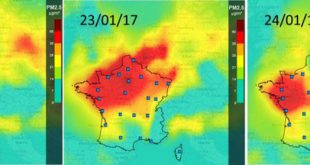The theme day on air quality modeling (organized by FIMEA and IMT Lille Douai) on June 8 provided an opportunity for researchers in this field to exchange on existing methods. Modeling makes it possible to identify the link between pollution sources and receptors. These models help provide an understanding of atmospheric processes and air pollution prevention. What will the pollution …
Read More »Health
Our exposure to electromagnetic waves: beware of popular belief
Joe Wiart, Télécom ParisTech – Institut Mines-Télécom, Université Paris-Saclay This article is published in partnership with “La Tête au carré”, the daily radio show on France Inter dedicated to the popularization of science, presented and produced by Mathieu Vidard. The author of this text, Joe Wiart, discussed his research on the show broadcast on April 28, 2017 accompanied by Aline Richard, …
Read More »IMT awards the title of Doctor Honoris Causa to Jay Humphrey, Professor at Yale University
This prestigious honor was awarded on 29 June at Mines Saint-Etienne by Philippe Jamet, President of IMT, in the presence of many important scientific, academic and institutional figures. IMT’s aim was to honor one of the inventors and pioneers of a new field of science – mechanobiology – which studies the effects of mechanical stress (stretches, compressions, shearing, etc.) on …
Read More »4D Imaging for Evaluating Facial Paralysis Treatment
Mohamed Daoudi is a researcher at IMT Lille Douai, and is currently working on an advanced system of 4-dimensional imaging to measure the after-effects of peripheral facial paralysis. This tool could prove especially useful to practitioners in measuring the severity of the damage and in their assessment of the efficacy of treatment. “Paralysis began with my tongue, followed by …
Read More »Particulate matter pollution peaks: detection and prevention
By Véronique Riffault, Professor of Atmospheric Sciences, IMT Lille Douai – Institut Mines-Télécom This article was originally published in French in The Conversation France. This winter, France and a large part of Europe were struck by episodes of particulate matter pollution. These microscopic particles are known as PM2.5 and PM10 when they measure less than 2.5 or 10 micrometers …
Read More »Removing pollutants from our homes
Indoor air is polluted with several volatile organic compounds, some of which are carcinogenic. Frédéric Thévenet, a researcher at Mines Douai, develops solutions for trapping and eliminating these pollutants, and for improving tests for air purifying devices. We spend nearly 90% of our time inside: at home, at the office, at school, or in our car. Yet the air …
Read More »City4age, the elderly-friendly H2020 project
In the framework of the European research program H2020, the Institut Mines-Telecom is taking part in the project « City4age ». The latter is meant to offer a smart city model adapted to the elderly. Through non-intrusive technologies, the aim is to improve their quality of life and to facilitate the action of Health Services. The researcher and director of the IPAL[1], …
Read More »Biomechanics serving healthcare
Stéphane Avril, a researcher at Mines Saint-Étienne, describes himself as a “biomechanics” but would like to become a “mechanobiologist”, a switch from studying the mechanical properties of the body to decoding its biological mechanisms using engineering tools. Focused in particular on analysis of the behavior of normal and pathological vessels, his work should have significant consequences on treatment for various …
Read More »Augmented Reality and Surgery: helping surgeons achieve ever-greater accuracy
Questions of health, well-being and personal independence are central preoccupations of all modern societies. Age-related illnesses, and our ageing populations, pose a number of social and economic challenges. Over the last two decades, information sciences and technologies have helped us rise to these challenges. Concepts such as distance health care and online treatment are now accepted as a part of …
Read More » I'MTech L'actualité scientifique et technologique de l'IMT
I'MTech L'actualité scientifique et technologique de l'IMT








